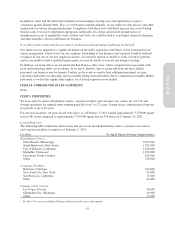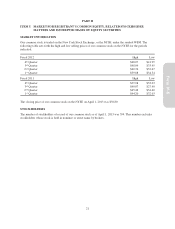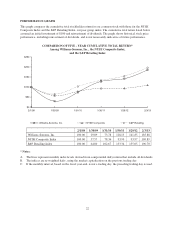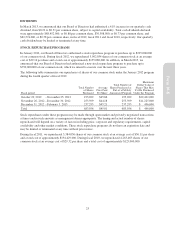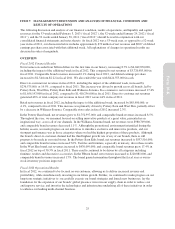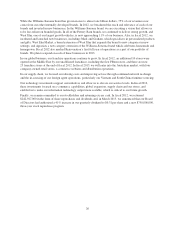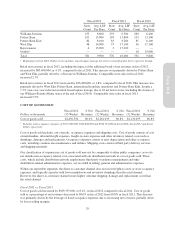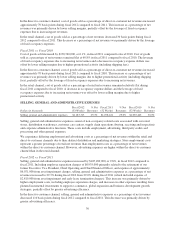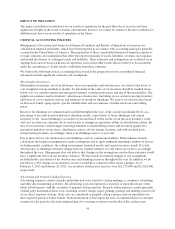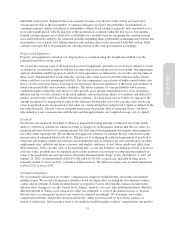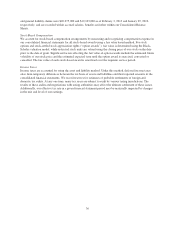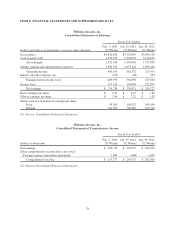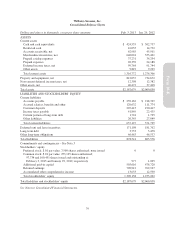Pottery Barn 2012 Annual Report Download - page 43
Download and view the complete annual report
Please find page 43 of the 2012 Pottery Barn annual report below. You can navigate through the pages in the report by either clicking on the pages listed below, or by using the keyword search tool below to find specific information within the annual report.
Fiscal 2012 Fiscal 2011 Fiscal 2010
Store
Count
Avg. LSF
Per Store
Store
Count
Avg. LSF
Per Store
Store
Count
Avg. LSF
Per Store
Williams-Sonoma 253 6,600 259 6,500 260 6,400
Pottery Barn 192 13,900 194 13,800 193 13,100
Pottery Barn Kids 84 8,100 83 8,200 85 8,100
West Elm 48 14,900 37 17,100 36 17,100
Rejuvenation 4 13,200 3 17,200 — —
Outlets1— — — — 18 19,600
Total 581 9,900 576 10,000 592 9,800
1Beginning in fiscal 2011, Outlet stores and their leased square footage have been reclassified into their respective brands.
Retail net revenues in fiscal 2012, including the impact of the additional week of net revenues in fiscal 2012,
increased by $85,400,000, or 4.1%, compared to fiscal 2011. This increase was primarily driven by Pottery Barn
and West Elm, partially offset by a decrease in Williams-Sonoma. Comparable store sales in fiscal 2012
increased 2.3%.
Retail net revenues in fiscal 2011 increased by $36,498,000, or 1.8%, compared to fiscal 2010. This increase was
primarily driven by West Elm, Pottery Barn, international franchise operations and Pottery Barn Kids, despite a
1.5% year-over-year reduction in retail leased square footage, due to 16 net fewer stores (including the closure of
our Williams-Sonoma Home stores at the end of fiscal 2010). Comparable store sales in fiscal 2011
increased 3.5%.
COST OF GOODS SOLD
Dollars in thousands
Fiscal 2012
(53 Weeks)
% Net
Revenues
Fiscal 2011
(52 Weeks)
% Net
Revenues
Fiscal 2010
(52 Weeks)
% Net
Revenues
Cost of goods sold1$2,450,394 60.6% $2,261,039 60.8% $2,130,299 60.8%
1Includes total occupancy expenses of $517,300,000, $500,660,000 and $506,712,000 in fiscal 2012, fiscal 2011 and fiscal
2010, respectively.
Cost of goods sold includes cost of goods, occupancy expenses and shipping costs. Cost of goods consists of cost
of merchandise, inbound freight expenses, freight-to-store expenses and other inventory related costs such as
shrinkage, damages and replacements. Occupancy expenses consist of rent, depreciation and other occupancy
costs, including common area maintenance and utilities. Shipping costs consist of third party delivery services
and shipping materials.
Our classification of expenses in cost of goods sold may not be comparable to other public companies, as we do
not include non-occupancy related costs associated with our distribution network in cost of goods sold. These
costs, which include distribution network employment, third party warehouse management and other
distribution-related administrative expenses, are recorded in selling, general and administrative expenses.
Within our reportable segments, the direct-to-customer channel does not incur freight-to-store or store occupancy
expenses, and typically operates with lower markdowns and inventory shrinkage than the retail channel.
However, the direct-to-customer channel incurs higher customer shipping, damage and replacement costs than
the retail channel.
Fiscal 2012 vs. Fiscal 2011
Cost of goods sold increased by $189,355,000, or 8.4%, in fiscal 2012 compared to fiscal 2011. Cost of goods
sold as a percentage of net revenues decreased to 60.6% in fiscal 2012 from 60.8% in fiscal 2011. This decrease
was primarily driven by the leverage of fixed occupancy expenses due to increasing net revenues, partially offset
by lower selling margins.
29
Form 10-K


